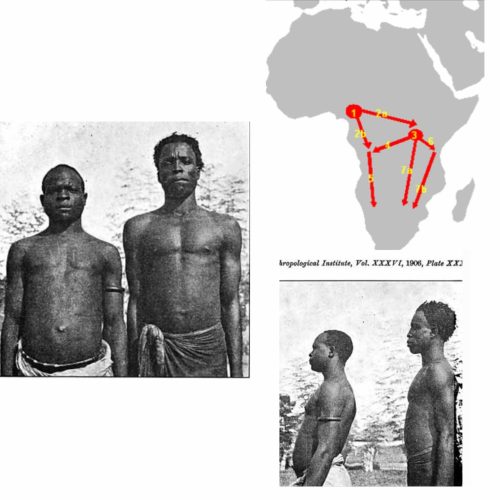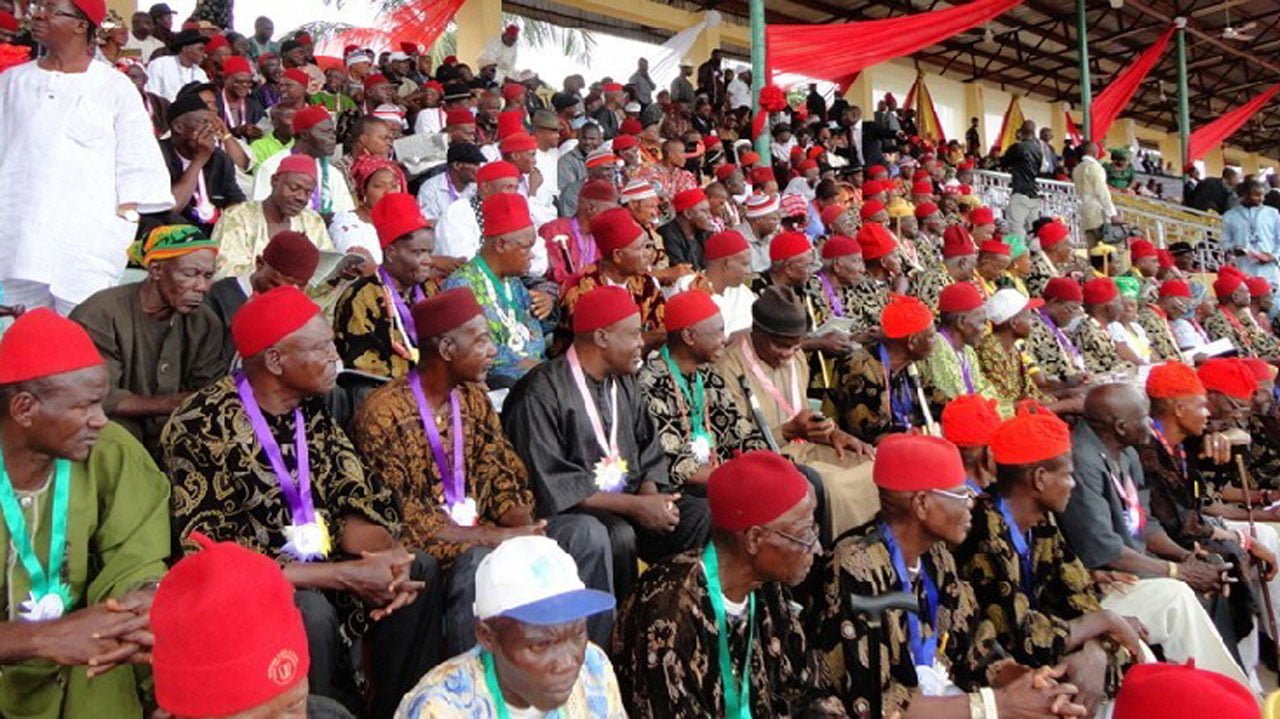The photo used in this article was taken in Igboland and published in the Journal of the Royal Anthropological Institute of Great Britain and Ireland in 1906, Volume 36.
I added a photo of the Bantu Expansion in the collage for context.
The authors were discussing the distinct different ancestries of the people who made up Igboland. Using these two Igbo men as examples, the paper noted their completely different body shapes, facial features, and general appearance.
One was short, and roundish, with a round face, scanty hair, a smaller skull, and a darker complexion. The other was tall, and slender, oval face, fuller hair that could be braided (Igbo boys/men used to braid their hair), a bigger skull, and fair-skinned. If you care to know what the authors wrote on the comparative intelligence of the two, go and read the journal.

The short man has Bantu features and can easily fit into the Bantu families in East Africa. He was probably a remnant of the Bantu who previously inhabited Igboland but were pushed out during the Bantu Expansion as shown in the map. The taller man has mixed ancestral features.
Below are some other citings pointing out the variation of Igbo skin colour compared to other Africans of the Negro belt. These strongly prove that the Igbo have mixed ancestry, and are rightly described as Semi-Bantu.
******************************************************
“The skin of the Eboes is of a light copper-colour.”
*-Researches Into the Physical History of Mankind: Ethnography, James Cowles Prichard, 1837
******************************************************
“In colour the Eboes are much fairer than the neighbouring people of the coast, many of them being of light copper colour.”
*-Researches Into the Physical History of Mankind, Volume 2, by James Cowles, Page 96, Published 1851
******************************************************
“The natives of Aboh are comparatively tall for West Africans; well made and muscular, but the hands and feet are large. The most prevalent colour of skin is yellowish or brownish-black.”
A narrative of the expedition sent by Her Majesty’s Government to the River Niger in 1841 under the command of Captain H.D. Trotter, Published in 1848
******************************************************
In America he was trusty, intelligent and industrious, but remarkable for an absolutely indomitable spirit, to which even the master must yield, when the Eboe was aroused, unless he should choose to shoot down the best slave on his plantation. No wonder: for the Eboes in common with the Sudanese, have undergone a strong Caucasian innervation, which is evidenced by the fact that some of them are nearly white.”
Central Africa: Adventures and Missionary Labors in Several Countries in the Interior of Africa, from 1849 to 1856, Thomas Jefferson Bowen, Southern Baptist Publication Society, 1857
*****************************************************
“The traveller is everywhere struck with the diversity of races. It was here that I first saw copper-coloured negroes, who are from everywhere in Ebo; they are fine men, well-grown, and carry their heads proudly; they nearly all have blue eyes. They talk a great deal, and speak loud and fast. When they are negotiating any business one would imagine them to be quarrelling and that there is going to be a fight.”.
*-The Niger and the Benueh: Travels in Central Africa by Adolphe Burdo, Pages 126-127 (1880)
*****************************************************
“Colour variations are prevalent from light olive to deepest black, and albinos are common. These freaks of nature are of unprepossessing appearance. They are not, however, treated as monstrosities; indeed the mother of an albino is usually gratified with her offspring. They are termed by the people “ndi-awcha,” i.e., white people.”
*-Among the Ibos of Nigeria, by G. T. Basden, Page 81, Published 1921
******************************************************
“Outsiders know little of the province of Nigeria in Africa and are acquainted still less with the interesting inhabitants of that dreaded district. The Ibo tribe, which furnishes half the population of Nigeria, with its patriarchal form of government and its firm belief of the supernatural, is well worthy of closer study. Though lying within the recognized negro belt, the colour of the Ibos varies from light olive to deep black.”
*-Catholic Missions and Annals of the Propagation of the Faith, Volume 2, Society for the Propagation of the Faith, 1925
********************************************************
All historical accounts of the early European contact with West Africa and the slave trade noted that the Igbo were lighter in complexion than their neighbours. Olaudah Equiano also noted the same in his book even as he argued that the Igbo must have been mixed with Hebrews and practised the same religion – Judaism.
.
Olaudah, in arguing about the difference in the skin colour of the Jews of Europe and the Igbo, mentioned other books on how the skin colour of Portuguese that mixed with Africans became mostly bronze/copper like the Igbo.
.
What you may not have known is that the skin colour type described as “copper colour” at that time is the exact skin type described as olive colour today. In the Fitzpatrick skin colour type scale, the copper skin colour is the IV colour type; the olive skin colour is equally the IV colour type in the scale.
.
Today, the Igbo are getting darker and darker, not because of the sun. Look at the pictures closely. In 200 years, the island from which these pictures were taken would not have changed much unless they become more mixed with darker skinned people. But because black is a dominant gene in skin pigmentation, they will still get darker. And that is why the Igbo are darker today than when they first had contact with Europeans.
By the way, some Yorubas were denied the right to vote in the Lagos State governorship election because they looked like Igbo.
Emeka Maduewesi is an Igbo-born, US-based intellectual property attorney and citizen journalist. Connect with him on X @maduewesi.
The opinions expressed in this article are solely those of the author.







